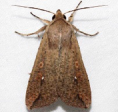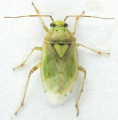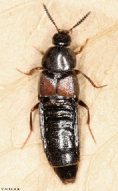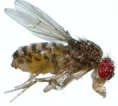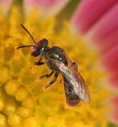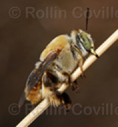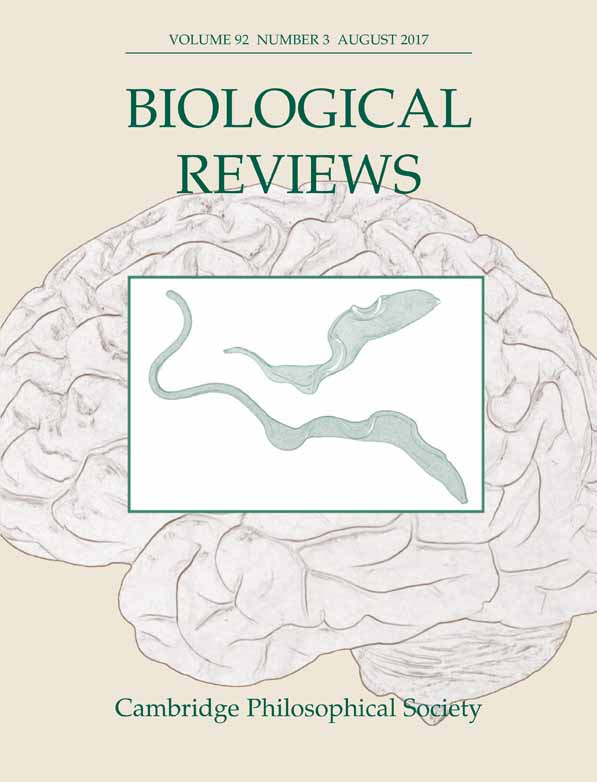Counter-perfume: using pheromones to prevent female remating
ABSTRACT
Strong selection to secure paternity in polyandrous species leads to the evolution of numerous chemicals in the male's seminal content. These include antiaphrodisiac pheromones, which are transmitted from the male to the female during mating to render her unattractive to subsequent males. An increasing number of species have been shown to use these chemicals. Herein, I examine the taxonomic distribution of species using antiaphrodisiac pheromones, the selection pressures driving their evolution in both males and females, and the ecological interactions in which these pheromones are involved. The literature review shows a highly skewed distribution of antiaphrodisiac use; all species currently known to use them are insects with the exception of the garter snakes Thamnophis sirtalis parietalis and T. radix. Nonetheless, many taxa have not yet been tested for the presence of antiaphrodisiacs, in groups both closely and distantly related to species known to express them. Within the Insecta, there have been multiple cases of convergent evolution of antiaphrodisiac pheromones using different chemical compounds and methods of transmission. Antiaphrodisiacs usually benefit males, but their effect on females is variable as they can either prevent them from mating multiple times or help them reduce male harassment when they are unreceptive. Some indirect costs of antiaphrodisiacs also impact both males and females, but more research is needed to determine how general this pattern is. Additional research is also important to understand how antiaphrodisiacs interact with the reproductive biology and sexual communication in different species.
I. INTRODUCTION: SECURING PATERNITY WITH CHEMICALS
In species where females reproduce with more than one partner, male reproductive success is influenced by competition pre-copulation for access to females and post-copulation by sperm competition and cryptic female choice. Post-copulatory competition can lead to the evolution of complex ejaculates consisting of additional compounds besides sperm (Gillott, 2003; Perry, Sirot & Wigby, 2013). Some of these ejaculate contents enhance female fertility and survival by stimulating egg production (Wedell, 2005) and providing nuptial gifts. Others increase male competitiveness by neutralizing previous sperm (Birkhead & Pizzari, 2002) or producing molecules that reduce sperm competition by hindering female remating (Takami et al., 2008). This chemical mate guarding can be achieved by producing mating plugs, which physically prevent other males from transferring sperm to the female, or the use of chemicals to make the female unreceptive or unattractive. Both strategies are less costly for the male than physical mate guarding, which requires extended proximity to the female after copulation (Brent & Byers, 2011). The chemicals used to reduce female receptivity are usually pheromones and they occur in both vertebrates and invertebrates (Poiani, 2006). The pheromones specifically reducing female attractiveness are called antiaphrodisiacs.
Antiaphrodisiacs (AA) are compounds transferred to the female during mating that make her unattractive to subsequent males for periods of time (Happ, 1969). They act by signalling to subsequent males the mating status of a female and directly repelling them rather than by manipulating the female's sex pheromones (Gillott, 2003; Brent & Byers, 2011). This is in contrast to male-transferred chemicals inducing hormonal changes in females that either stop her from producing male-attracting chemicals or induce her to produce male-repelling ones. AAs are usually transmitted in the seminal fluid, but other transmission modes exist such as cuticular contact or mating plugs (Carlson & Schlein, 1991; Schulz et al., 2008; Brent & Byers, 2011). AAs are classified as pheromones because they are molecules released by one individual to communicate with a conspecific, but it should be noted that the female releasing the pheromone is not the individual who produced it. Their effect can be so strong that males will not court a virgin female to which an AA pheromone has been artificially applied (Andersson, Borg-Karlson & Wiklund, 2000).
Despite an increasing number of species observed to use AA pheromones, few studies of seminal fluids take them into account, and there are no reviews of their taxonomic distribution. Here, I review all studies of AAs across the animal kingdom found in a thorough bibliographic search. All studies concur that AAs benefit males, but their effects on females are more controversial. I explore whether these chemicals are adaptive for both sexes or if they result from sexual conflict between males and females. Finally, I discuss their implication in other ecological interactions and potential applications.
II. TAXONOMIC DISTRIBUTION OF SPECIES USING ANTIAPHRODISIACS
AAs have been described in 14 genera, 13 of which are in the Insecta (Table 1). Most studies documenting these pheromones are recent, which suggests growing interest in this topic, but the overall number of studies remains small.
| Order | Species | Compounds | Transmission mode | References |
|---|---|---|---|---|
| Lepidoptera | ||||
|
|
Pieris brassicae | Benzyl cyanide | Spermatophore |
Andersson et al. (2003) |
|
© GFDL |
Pieris napi | Methyl salicylate | Spermatophore |
Andersson et al. (2000) |
|
© Bob Moul |
Pieris rapae | Methyl salicylate and indole | Spermatophore |
Andersson et al. (2003) |
|
© GFDL |
Heliconius erato | Beta-ocimene and dihydrofarnesenic acid | Unknown |
Gilbert (1976) |
|
|
Heliconius melpomene | Beta-ocimene | Unknown |
Schulz et al. (2008) |
|
© Ken Childs |
Pseudaletia unipuncta | Benzaldehyde1 | Unknown |
Hirai et al. (2013) |
| Hemiptera | ||||
|
© J. Fabrickars.usda.gov |
Lygus hesperus | Myristyl acetate | Spermatophore |
Brent & Byers (2011) |
|
© Bill Johnson 2015 |
Lygus lineolaris1 | Myristyl acetate | Spermatophore |
Brent & Byers (2011) |
|
2011 Jim Moore |
Lygus elisus1 | Myristyl acetate | Spermatophore |
Brent & Byers (2011) |
| Coleoptera | ||||
|
© Kerbtier.de |
Aleochara curtula | Unknown | Spermatophore |
Schlechter-Helas et al. (2011) |
|
© Biopix: N Sloth |
Tenebrio molitor | Unknown | Spermatophore1 |
Happ (1969) |
| Diptera | ||||
|
© istockphoto/janeff |
Drosophila melanogaster | 7-Tricosene | Cuticular contact |
Scott (1986) |
| Cis-vaccenyl acetate | Seminal fluid |
Ejima et al. (2007) |
||
| CH5O3 | Seminal fluid1 |
Yew et al. (2009) |
||
|
© Ecol. Evol. |
Drosophila arizonae | Triacylglycerides and acetyldienyl acetates | Seminal fluid |
Chin et al. (2014) |
|
© Ecol. Evol. |
Drosophila mojavensis | Triacylglycerides and acetyldienyl acetates | Seminal fluid |
Chin et al. (2014) |
| No picture available | Drosophila navojoa | Triacylglycerides and acetyldienyl acetates | Seminal fluid |
Chin et al. (2014) |
|
© Ray Wilson |
Glossina morsitans | Polymethylalkenes (19,23-dimethyltritriacont-1-ene) | Cuticular contact |
Carlson & Schlein (1991) |
| Hymenoptera | ||||
|
© Lynette Schimming discoverlife.org |
Lasioglossum zephyrum2 | Unknown | Unknown | Kukuk (1985), Wcislo (1987) and Ayasse et al. (2001) |
|
© Andreas Haselböck naturspaziergang.de |
Lasioglossum malachurum | Hexadecyl octadecenoate | Cuticular contact |
Ayasse et al. (2001) |
|
|
Bombus terrestris | Linoleic acid | Mating plug | Baer et al. (2001) and Baer & Boomsama (2004) |
|
© Alex Wild |
Solenopsis invicta1 | Linoleic acid | Mating plug |
Mikheyev (2003) |
|
© entomart.be |
Osmia rufa | (Z)-7-Ethyl hexadecenoate | Wing–stermite contact |
Ayasse et al. (2001) |
|
© Rollin Coville |
Centris adani | Unknown | Unknown |
Ayasse et al. (2001) |
| Squamata | ||||
|
© Y&T Klesius 2007 |
Thamnophis sirtalis parietalis | Unknown | Seminal fluid | Shine et al. (2000) and Friesen et al. (2013) |
|
© 2011 Eric Vanderduys |
Thamnophis radix | Unknown | Mating plug |
Ross & Crews (1978) |
- 1 Suspected.
- 2 Debate remains for this species.
(1) Coleoptera
The first record of an AA pheromone was in the mealworm beetle Tenebrio molitor (Happ, 1969). This is a highly polygynandrous species in which the AA pheromone acts shortly after mating by reducing long-distance attractiveness of females (Carazo, Fernández-Perea & Font, 2012). The only other coleopteran known to express an AA is the rove beetle Aleochara curtula, which transfers the pheromone through a spermatophore (capsule encompassing the spermatozoa and containing nutrients transferred from males to females during copulation; Schlechter-Helas, Schmitt & Peschke, 2011). Both species have very high last-male sperm precedence (Simmons, 2001; Drnevich, 2003), i.e. most of the eggs are fertilized by the sperm of the last male to mate with a female before oviposition. Some other species of Coleoptera have been argued to use AAs, but they do not act directly as a repelling signal; instead, they mask female pheromones (Trypodendron lineatum; Nijholt, 1973) or induce a refractory period in females that makes them unreceptive (Leptocarabus procerulusi; Takami et al., 2008).
(2) Lepidoptera
AAs have been best documented in lepidopterans. Gilbert (1976) first recorded them in Heliconius erato, with recent studies investigating further Heliconius species (Schulz et al., 2008; Estrada et al., 2011). The chemical compound was identified as beta-ocimene in H. melpomene (Schulz et al., 2008). In the most comprehensive study of AA evolution to date (Estrada et al., 2011) AAs compounds were identified and compared across 11 Heliconius species. This study showed an absence of phylogenetic signal, suggesting a rapid diversification among species. Heliconius butterflies encompass two clades: one is monoandrous with pupal mating and the other polyandrous. Estrada et al. (2011) found a faster rate of divergence in AA chemicals in the polyandrous group with more sperm competition as opposed to the pupal-mating group. Another comparison of AAs among species of a single genus was performed by Andersson et al. (2000); Andersson, Borg-Karlson & Wiklund (2003) in pierid butterflies. Pieris napi uses methyl salicylate as an AA (Andersson et al., 2000), which is also used by P. rapae in association with indole, whereas P. brassicae uses benzyl cyanide (Andersson et al., 2003). In the latter species, the fragrance transferred is a male-specific pheromone, suggesting that mated females become unattractive by expressing a male signal. The three pierid butterflies seem to transfer their AA through the spermatophore (Andersson et al., 2000, 2003). Both genera of butterflies described here exhibit last-male sperm precedence (Gilbert, 1976; Simmons, 2001; Andersson et al., 2003).
The most recent lepidopteran recorded to express AA pheromones is the armyworm moth, Pseudaletia unipuncta (Noctuidae; Hirai, Shorey & Gaston, 2013). Unlike other lepidopteran species using AAs, this moth has relatively low last-male sperm precedence (the proportion of offspring sired by the last male in a two-males experiment p2 = 0.47; Simmons, 2001). The specific AA compound has not been identified, but mated females have a scent which is associated with the expression of benzaldehyde, making this molecule the suspected AA. In other moth species, females become unattractive or unreceptive after mating because male-transferred molecules switch off the production of sex pheromones in the female, therefore acting only indirectly as an AA (Raina, 1989; Giebultowicz et al., 1991; Gillott, 2003).
(3) Diptera
AAs have also been studied in species of Drosophila and in the tsetse fly Glossina morsitans (Table 1; Thomas, 2011). Both D. melanogaster and G. morsitans have cuticular pheromones transferred by contact during mating that function as AAs (Scott, 1986; Carlson & Schlein, 1991). In addition to these, D. melanogaster transfers two other AAs in the seminal fluid: the compound cis-vaccenyl acetate and the long-chained acetate CH5O3 (Ejima et al., 2007; Yew et al., 2009). Cis-vaccenyl acetate is typically found in the ejaculatory bulb and cuticle of males only, making it a male-specific signal. Thus, recently mated females become unattractive by expressing a male fragrance, similar to the situation in the lepidopteran P. brassicae. However, the cis-vaccenyl acetate is only expressed for up to two days after copulation so the only AA that female fruit flies express for a longer time is the CH5O3, which is present for at least 10 days post-copulation on the surface the anogenital region (Yew et al., 2009). D. melanogaster is the only species recorded to use a combination of different AAs that are chemically distinct and are transmitted through different modes. This may be due to the unusually high last-male sperm precedence in this species (p2 = 0.93 compared to p2 = 0.11–0.45 in G. morsitans; Simmons, 2001) imposing a strong selection pressure on males to be the last to mate with a female before fertilization.
The three other Drosophila species found to use AAs are part of the D. repleta group – drosophilids adapted to desert environments that feed on fermented cacti. Their AA compounds are a mixture of triacylglycerides (lipids typically found in fat bodies that function in energy storage) acting synergistically with long-chain acetyldienyl acetates (Chin et al., 2014). These are unusual chemicals to be used as pheromones, particularly when compared to the volatile compounds used as AAs in most other species, but this may be related to the unique diet of these desert-living flies. Alternatively, such chemical compounds may be present as AAs in other species too, but have not been identified in pheromone studies because they are not detectable with the typical methods used to identify volatile compounds (gas chromatography and mass spectrometry; Yew et al., 2009). Chin et al. (2014) found that the triacylglycerides used as pheromones are conserved across the D. repleta group as well as the related D. virilis and D. robusta taxa. It is thus likely that AA pheromones are used in all 11 species making up these three taxa.
(4) Hymenoptera
AAs have been recorded in several hymenopteran families. The male bee Osmia rufa (Megachilidae) uses cuticular transfer to transmit 7-ethylhexadecenoate to the female by rubbing the female's wings with its stermites after copulation (Ayasse, Paxton & Teng, 2001). Other bees in which AA pheromones are known include Centris adani (Ayasse et al., 2001), the sweat bee Lasioglossum malachurum, and possibly Lasioglossum zephyrum, which was initially reported to use an AA (Kukuk, 1985) although behavioural experiments failed to confirm this (Wcislo, 1987). Finally, the bumble bee Bombus terrestris uses linoleic acid as an AA in a mating plug (Baer & Boomsama, 2004). The mating plug itself is not enough to preclude subsequent mating, as other males can displace it, whereas the presence of linoleic acid is effective. Linoleic acid has also been suspected to act as an AA in the fire ant Solenopsis invicta. The same fatty acids are produced in this ant as in the bumble bee B. terrestris, including linoleic acid which is transferred to the female during mating (Mikheyev, 2003). Its use as an AA remains to be proven but seems highly plausible.
(5) Hemiptera
Only one hemipteran species, Lygus hesperus, has been shown to use an AA (Brent & Byers, 2011). As in pierid butterflies, this compound – myristyl acetate – is transmitted through the spermatophore (Brent & Byers, 2011). Two species of the same genus, L. lineolaris and L. elisus, are also suspected to use myristyl acetate as an AA but this remains to be confirmed. Myristyl acetate is present in males and mated females but not in virgin females, which is similar to the pattern observed in L. hesperus.
(6) Orthoptera
A pheromone similar to an AA has been identified in the desert locust Schistocerca gregaria and the term AA has been used to describe it (Seidelmann & Ferenz, 2002). Because there is total sperm precedence in this species (p2 = 1; Simmons, 2001), gregarious males remain in close proximity to the female to prevent remating until egg laying. But in crowded situations other males are able to separate the pair and do so if the repelling pheromone phenylacetonitrile is not emitted. However, this phenylacetonitrile is secreted directly by the male, therefore not falling strictly into the definition of an AA pheromone which must be transferred to the female. A similar finding has been reported in the sweat bee Lasioglossum malachurum (Ayasse, 1994) where an ester emitted from the cuticle of males during copulation repels other males. The inhibitory effect on other males is specifically efficient with individuals from the same population.
(7) Squamata
The only records of AA pheromones outside of the Insecta are in the garter snakes Thamnophis radix (Ross & Crews, 1978) and T. sirtalis parietalis (Friesen et al., 2013). These pheromones are transferred through a mating plug in T. radix, whereas the transfer is more likely in the seminal fluid and independent of the mating plug in T. sirtalis parietalis (Shine, Olsson & Mason, 2000). The AA compound has yet to be identified, although Mason & Parker (2010) suggested that it might be squalene. Squalene is a potential sex identifier since it is found in the skin of male garter snakes but not females, and Shine et al. (2005) showed that experimentally applying squalene on females repels males. However, artificially adding a male-specific molecule to females would make them unattractive even if this compound is not used as an AA in nature, and thus the role of squalene as an AA awaits further investigation.
(8) Convergent evolution?
The above review shows that AAs are present in many different taxa within the insects, with garter snakes the sole example outside this group. Although AAs are found in multiple insect orders, only a few species within each order use these pheromones, suggesting multiple cases of independent evolution of AAs. This is also supported by the diversity of transmission modes: seminal fluid, cuticular contact, mating plug, and spermatophore. Indeed, transmission mode does not correlate strictly with taxon, although closely related species often use the same transmission mode.
In some instances, the AA compound is the same as a male-specific pheromone, thus making mated females signal themselves with a male identifier to repel potential mates. This strategy seems less costly and easier to evolve than the use of a new chemical, which may be why it arose in three different taxa. In particular, using a male-specific odour as an AA can be highly beneficial in species where the AA is not an honest signal of female receptivity. In that case, selection pressures would favour other males to evolve resistance to AA signal, which could be avoided if the signal is also used as honest information in male–male communication.
The convergent evolution of AA pheromones among different taxa suggests substantial benefits to their acquisition. If such benefits are present, why are AAs restricted to these few taxa, and are the benefits the same for males and females?
III. WHY ARE ANTIAPHRODISIACS MORE COMMON IN INSECTS?
There are several possible explanations for the phylogenetic bias in AA distribution. First, insects might be particularly likely to use AAs because of their usually promiscuous and polyandrous mating systems. Because females mate with many males, there is strong intra-sexual competition and potential for the evolution of traits to secure paternity. In line with this hypothesis, the only vertebrates known to use AAs are garter snakes, whose life history promotes a highly male-biased operational sex ratio: males emerges from brumation (the low-metabolism state in which garter snakes spend the winter months) at higher density than females in early spring and remain in the vicinity of emerging females to mate multiple times, whereas females emerge at lower density throughout the season and disperse after the first mating (Ross & Crews, 1978). In insects, the importance of sperm competition and selection to prevent female remating is enhanced because of last-male sperm precedence. Nevertheless, this sperm precedence pattern is not universal among insect species, including those using AAs. It may strengthen the potential for AAs but other factors are no doubt in play. Moreover, not all insect species are polyandrous and some non-insects are, raising the question of why AAs did not evolve in these other groups too. The importance of mating system and sperm precedence in the evolution of AAs could be tested by examining the distribution of these pheromones in closely related species where one is monoandrous and the other polyandrous, as well as in polyandrous species with and without sperm precedence. If these factors are driving forces in the evolution of AAs, we should find more AA pheromones in the promiscuous and last-male sperm precedence species than in others.
Second, insects use chemical communication more than many other taxa (Symonds & Elgar, 2008), making them more likely to evolve specific pheromones, such as the AAs. Selection pressures might be similar in different groups, but the chance of having AAs appear may be higher in insects due to the existence of other pheromones and pheromonal pathways in their metabolism. This hypothesis could also be tested using the comparative method, looking at the distribution of AAs between groups which vary in their use of pheromones. We would expect the presence of AAs to be correlated with extensive use of chemical communication. Furthermore, the chemical structure of AAs and their metabolic pathways could be compared to other pheromones to see if they have evolved from a common ancestral molecule.
Third, AAs might be present in other groups where they have not been investigated. There are only four species in which an absence of AAs has been documented, all part of the Insecta: the house cricket Acheta domesticus (Fleischman & Sakaluk, 2004), the ant Leptothorax gredleri (in which the cuticular pheromones change after mating due to a change in the female's physiology; Oppelt & Heinze, 2009), the honey bee Apis mellifera, where a mating sign transferred from males to females during copulation increases their chance of remating (Koeniger, 1990), and the African migratory locust Locusta migratoria (Seidelmann & Ferenz, 2002). To my knowledge, no study of AAs has been published in other groups and further research should investigate whether AAs in groups other than insects are absent or simply undocumented.
If AAs are present in other taxa, they would be expected to evolve in species showing internal fertilization, multiple mating with last-male precedence and strong use of pheromonal communication. For instance, many mammals use olfactory senses and pheromones as a major communication route, especially in the context of reproduction (Vandenbergh, 1983). In addition, they often have multiple matings leading to sperm competition. This is the case in rodents, where some species like prairie voles and hamsters have also been shown to have high last-male precedence (Dewsbury, 1984), thus exhibiting all conditions likely to favour the evolution of AAs. It should be noted that other rodent species like house mice exhibit opposite patterns of sperm precedence and are therefore unlikely to use AA pheromones. Other taxa with characteristics relevant to the development of AAs include some species of fish and birds. Poeciliidae are live-bearing fishes, most of them with internal fertilization. They use pheromones as part of their reproductive behaviour, and the existence of multiple mating with last-male precedence (Constantz, 1984) makes them a highly suitable target for investigating the presence of AAs. Birds also have strong last-male precedence (Briskie, 1996), and although chemical communication has usually been considered less significant in this group, recent studies suggest that olfactory communication is present and that pheromones may well be employed (Caro & Balthazart, 2010). Knowing the full distribution of AAs would help understand their evolutionary and ecological impacts. These impacts may be different for males and females.
IV. DO ANTIAPHRODISIACS BENEFIT BOTH SEXES?
(1) Males
In promiscuous species, as well as in socially monogamous species where females exhibit extra-pair matings, males are subject to strong intra-sexual competition in order to access females and secure paternity. This leads to numerous morphological, physiological, chemical and behavioural adaptations. Examples of such adaptations include the evolution of weapons to fight other males for access to females (Emlen, 2008), increased testosterone levels (Martínez-Padilla et al., 2014), sperm competition between the seminal fluid of different males (Edward, Stockley & Hosken, 2015) and physical mate guarding (Edward et al., 2015). Sperm competition can either affect the evolution of the sperm itself, for instance by increasing its size or longevity (Parker, 1998), or it can affect the other molecules present in the ejaculate (Cameron, Day & Rowe, 2007). These seminal fluid contents transmitted along with the sperm increase reproductive success in three different ways: they have an ‘offence’ effect when they replace sperm already present in the female; a ‘defence’ one when they protect their sperm from being displaced by future males; or an ‘avoidance’ effect when they prevent sperm competition from happening altogether (Dhole & Servedio, 2014). Antiaphrodisiacs fall into the avoidance category: they make the female appear unattractive and thus prevent future sperm competition from happening. This is a strong benefit for males, particularly in species with a high degree of last sperm precedence.
If the selection pressure to secure paternity through access to females is strong enough to lead to extreme morphological adaptations like the eyestalks of the stalk-eyed fly, or the horns of Hercules beetles (Emlen, 2008), we can expect a similar pressure on the evolution of the ejaculate compounds transmitted to females during mating. Any such compound that provides reduced competition from the sperm of other males would thus be highly beneficial to the individual producing it.
Additionally, AAs can benefit males in two other ways. First, when females have a refractory period after mating AAs can function as honest signals of females' lack of receptivity and prevent subsequent males from wasting time and energy courting unreceptive females (Daly, 1978; Ross & Crews, 1978; Andersson et al., 2003; Estrada et al., 2011). This is especially important in species where copulation cannot be forced, such as some species of Lepidoptera (e.g. Pieridae and Heliconius species; Gilbert, 1976; Andersson et al., 2003). Second, if males court females despite the expression of AAs and copulation ensues, they can use these pheromones as information that there is likely to be sperm competition due to the female's previous mating. Having that information can influence their mating behaviour to maximize fitness, as has been observed in P. napi. The males of this butterfly species use the expression of the AA methyl salicylate to assess the female's mating status, and transmit an ejaculate on average 26% larger to mated females than to virgin ones to improve their chances of fertilizing the eggs in the presence of competition with the sperm of a previous male (Larsdotter-Mellström et al., 2015).
The use of AA pheromones thus has multiple advantages for males, the major one being an increased chance of fertilizing eggs by reducing sperm competition. The effects on females, however, are more complex.
(2) Females
Even though the optimal number of partners is lower for females than for males (Bateman's principle), they can still benefit from multiple matings (Eberhard, 1998). These benefits might be direct by providing fertility insurance and nutrients to the female (Hosken & Blanckenhorn, 1983), as is the case in some lepidopteran species. For example, female pierid butterflies gain nuptial gifts during copulation events (Andersson et al., 2003), and in Heliconius erato additional spermatophores increase female fecundity (Gilbert, 1976). Benefits of multiple matings might also be genetic by compensating for low-quality partners (Hosken & Blanckenhorn, 1983), avoiding genetic incompatibilities (Hosken & Blanckenhorn, 1983), acquiring ‘good genes’ (Yasui, 1998), and enhancing the genetic diversity of offspring – which favours different gene by environment interactions (Yasui, 1998). AAs incur a cost to females by reducing their chances of remating and thus of accessing these various benefits of multiple mating.
Nevertheless, most females have a refractory period after mating. In this case, it is advantageous for them to have an honest signal of their mating status that will reduce harassment from males, therefore saving females time and energy (Gilbert, 1976; Andersson et al., 2003; Estrada et al., 2011). In garter snakes, for example, removing the mating plug containing AAs makes the female attractive again, but she is still unreceptive. In this species, as in many others, avoiding male harassment is especially important because mating increases exposure to predators. Other organisms might experience similar trade-offs, such as between mating and laying eggs (e.g. pierid butterflies; Andersson et al., 2003). In addition to reducing male harassment, AAs can benefit females in species where mating damages females' organs, as is for example the case in D. melanogaster where the male wounds the female's vaginal wall during copulation (Mattei et al., 2015). The expression of AA pheromones in this species might allow females to avoid unnecessary matings and the ensuing internal damage. This could explain why D. melanogaster has several different molecules used as AAs; a sex pheromone is more likely to evolve if it has significant benefits for both sexes. Alternatively, this apparent higher diversity of AA pheromones in the fruit fly may simply result from the higher number of studies on this model organism.
In Heliconius erato, females seem to have evolved specific structures called ‘stink-clubs’ to disseminate AAs (Eltringham, 1925; Gilbert, 1976), suggesting selection pressures favouring AAs in this sex. The impact of AAs on female fitness then depends on the control females have on the release of the pheromones. An honest signal is beneficial for females, but if AAs are expressed for longer than the female is unreceptive this becomes a cost (Andersson et al., 2003; Estrada et al., 2011). In most species, it seems that females do not have such control on the release of AAs, but further research is needed to explore this. There is no evidence of evolution of resistance to AAs by females, which would be expected if these pheromones were highly detrimental to their fitness, but this has not been investigated systematically.
In several species, there is evidence for both evolutionary advantages and disadvantages to AAs in females. In H. erato for instance, females suffer the cost of a reduced number of spermatophores, and the resources they contain, if they mate only once, but have nonetheless evolved structures to disseminate male-transferred AA. Similarly, it is unclear whether females of the rove beetle Aleochara curtula benefit or suffer a cost from AAs: mated females do not alter their production of aphrodisiac pheromones, which suggests that they are still willing to mate after copulation, but females without AA refuse to do so and spend 60% of their time repulsing males (Peschke, 1987; Schlechter-Helas et al., 2011).Whether AAs are favourable or costly to females would influence how these pheromones interact with other components of the ejaculate transferred during mating, notably in situations where AAs are transferred through a mating plug or spermatophore. Mating plugs are detrimental to females' fitness since they prevent the females from remating without any apparent female control on the presence of the plug. Thus, the expression of AA pheromones transmitted through this route is probably not controlled by females and is presumably deleterious to them. Alternatively, AAs may act as a signal when transferred with a plug, preventing subsequent males from wasting time courting a female that cannot mate. Even if the female would ultimately benefit from a second mating, the plug does not allow this and her best strategy would be to not waste time courting or rejecting other males. Spermatophores, on the other hand, often benefit females by providing them with resources (Boggs, 1995). We could therefore expect AAs to be beneficial for females in species where they are transmitted through this route, as females may have more control on their expression. But it could also be a successful evolutionary strategy for males to transmit costly pheromones with beneficial resources since that would make the evolution of resistance in females less likely.
V. ECOLOGICAL IMPACTS OF ANTIAPHRODISIACS
In some cases, both sexes may suffer a cost from AAs. Natural enemies like parasitoids often intercept chemical communication to locate their hosts, and there are examples of AAs being used in this way. The parasitic wasps Trichogramma brassicae and T. evanescens use AAs to find their hosts Pieris brassicae and P. rapae. This happens in two different ways: first, both Trichogramma species hitch-hike on P. brassicae by using the AA to locate mated females and then ride on them to the oviposition site to infect the eggs (Fatouros et al., 2005; Huigens et al., 2009); second, this interaction can be plant-mediated, which is not an unexpected adaptation since it is advantageous to the plant to facilitate parasitoid attraction for protection against herbivorous insects. Mated P. brassicae and P. rapae females prompt the production of synomones by Brussels sprouts to attract the Trichogramma parasitoids T. brassicae and T. evanescens (Fatouros et al., 2008, 2009; Pashalidou et al., 2010). The latter species responds only to the plant cues induced by P. rapae. The two Trichogramma species use different AAs but both molecules are also produced by the host plant, suggesting potential interactions between the plant and insect chemicals (Andersson et al., 2003).
The use of AAs by plants and natural enemies has not been explored in other systems and additional studies are needed to determine whether this is a general pattern or not. The plant-mediated impact of natural enemies could be used for biocontrol in Pieridae, as well as to provide new insights for management of other pest species if similar patterns are present. But the possible use of AA pheromones in biological control is not restricted to species interacting with parasitoids; AAs could also be incorporated in biological control programs for invasive species, insect pests (Brent & Byers, 2011) and disease vectors (e.g. Tsetse fly) to reduce females' attractiveness and thus reproduction.
VI. ANTIAPHRODISIACS AND SPECIATION
In addition to their ecological implications, AAs also have evolutionary consequences. Because they are a type of chemical communication, they can be involved in species recognition. Among the few studies comparing AA compounds between closely related species, two out of three genera have different molecules used by the different species (Table 1; Andersson et al., 2003; Brent & Byers, 2011; Estrada et al., 2011). The mode of transfer, however, is shared by all species of each genus. This suggests that the transfer of AAs evolved ancestrally in these genera with the signal then becoming species-specific. This hypothesis of ancestral signal evolution followed by more recent divergence is also supported by the fact that AAs in closely related species are different but share some of their compounds, which is not the case for AA pheromones of distantly related species (Table 1).
Rapid signal diversification is observed in the lepidopteran genera Pieris and Heliconius (Andersson et al., 2003; Estrada et al., 2011). In addition, AAs can be race-specific as in Heliconius erato (Gilbert, 1976), which could create isolation between races possibly leading to speciation. It is unknown whether the signal diversification in most species occurred before or after speciation and how it interacted with the speciation process. This could be explored by investigating the coalescence time for genes encoding AA pheromones and comparing this to species divergence times. Increasing the number of studies comparing AA pheromones in closely related species would also help to understand how AAs contribute to speciation and show whether rapid signal diversification is a widespread phenomenon. Inter-sexual coevolution due to post-copulation sexual selection has been shown to be a potential driver of reproductive isolation and eventually speciation in other systems, but the extent of this phenomenon is not clearly defined (Birkhead & Pizzari, 2002). AAs could be used to study this question.
VII. CONCLUSIONS
- Antiaphrodisiacs are pheromones transmitted from males to females during copulation to make the female unattractive to subsequent males. They can be transferred as part of the seminal fluid, in a spermatophore, through cuticular contact or in a mating plug.
- The repeated evolution of these pheromones in different insect families across five orders suggests strong selection pressures favouring their appearance and maintenance. The strong phylogenetic signal towards insects in AA distribution might be due to the importance of chemical communication in this group, making them more prone to evolve such pheromones. But the discovery of AA pheromones in two species of Thamnophis snakes suggests a potentially more widespread distribution.
- The benefit of AAs on males' reproductive success is clear: AAs help males to avoid sperm competition and secure paternity. The effect on females, however, is more ambiguous. On one side, AAs are likely to be detrimental to females' fitness since they reduce their number of mating partners and thus the benefits of multiple mating. But on the other side, they may be beneficial by reducing male harassment when females are not receptive, especially if females have control over their release.
- Investigating AA distribution and evolution is crucial for a full understanding of reproductive biology and could explain patterns of attractiveness in species where the presence of AAs has not been tested yet. AAs also play an important role in sperm competition and would thus benefit from being included in studies of this topic, as well as in research on sexual conflict.
- AAs have been shown to be involved in speciation in several taxa and can be used to study signal evolution. They are also used in some ecological interactions and could potentially be used for biological control.
- There is still much to learn on the topic of AA pheromones, in particular in the following areas: (i) to understand the impact of AAs on females' fitness, we need further investigation of the physiology of AA pheromones, how they are produced and perceived by males, as well as stored and expressed by the females. (ii) There is a lack of studies looking at how AA pheromones interact with other pheromones involved in sexual communication, such as those produced directly by females to attract or deter males, as well as with other communication systems such as visual or acoustic cues. (iii) Further research is needed to explore the existence of AAs in other species, both within the Insecta and in other taxonomic groups. In particular, AAs are likely to be present in species that have high sperm competition and use pheromonal communication extensively. (iv) Increasing the number of comparative studies of AAs within closely related species would help to clarify the evolution of AA pheromonal communication.
VIII. ACKNOWLEDGMENTS
I thank Mike Ryan for his help in developing this manuscript and reviewing it several times, Catalina Estrada and Patrick Schultz for their comments, Larry Gilbert for his support and Pierre-Antoine Precigout for helping me find the title.








